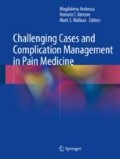Abstract
Intrathecal drug delivery devices offer a unique method of pain control from malignancy when more conservative methods fail. Such devices are also used to administer intrathecal baclofen in the treatment of spasticity and dystonia refractory to oral therapy. Unique challenges in wound healing exist in each patient. For patients with malignant pain, these challenges include malnourishment and infection secondary to immunosuppression from chemotherapy, both potentially increasing the risk of postoperative wound infection and impairing healing. Wound infection in intrathecal drug delivery most commonly occurs at the reservoir insertion site. Those infections are treated with long-term intravenous antibiotics or device revision or removal. Untreated, death may result from meningitis and sepsis. To prevent postoperative wound infection after intrathecal pump implantation, selection of patients, technique, insertion site, and wound care postoperatively must be reviewed carefully.
Access this chapter
Tax calculation will be finalised at checkout
Purchases are for personal use only
References
Follett KA, Boortz-Marx RL, Drake JM, et al. Prevention and management of intrathecal drug delivery and spinal cord stimulation system infections. Anesthesiology. 2004;100(6):1582–94.
Deibert CP, Gandhoke GS, Forsythe RM, et al. Surgical site infection 18 months following intrathecal pump placement secondary to an asymptomatic bowel injury. Pain Pract. 2015;15(7):E69–71.
Engle MP, Vinh BP, Harun N, et al. Infectious complications related to intrathecal drug delivery system and spinal cord stimulator system implantations at a comprehensive cancer pain center. Pain Physician. 2013;16(3):251–7.
Malheiro L, Gomes A, Barbosa P, et al. Infectious complications of intrathecal drug administration systems for spasticity and chronic pain: 145 patients from a tertiary care center. Neuromodulation. 2015;18(5):421–7.
Zhou L, Villanueva J, Desai MJ, et al. Acute exacerbation of hereditary coproporphyria mimics early surgical infection following intrathecal pump implantation for chronic abdominal pain: a case report. Neuromodulation. 2010;13(4):296–8.
Samuel M, Finnerty GT, Rudge P. Intrathecal baclofen pump infection treated by adjunct intrareservoir antibiotic instillation. J Neurol Neurosurg Psychiatry. 1994;57(9):1146–7.
Levin I, Amer-Alshiek J, Avni A, et al. Chlorhexidine and alcohol versus povidone-iodine for antisepsis in gynecological surgery. J Womens Health (Larchmt). 2011;20(3):321–4.
Mimoz O, Lucet JC, Kerforne T, et al. Skin antisepsis with chlorhexidine-alcohol versus povidone iodine-alcohol, with and without skin scrubbing, for prevention of intravascular-catheter-related infection (CLEAN): an open-label, multicentre, randomised, controlled, two-by-two factorial trial. Lancet. 2015;386(10008):2069–77.
Beltran RJ, Kako H, Chovanec T, et al. Penicillin allergy and surgical prophylaxis: cephalosporin cross-reactivity risk in a pediatric tertiary care center. J Pediatr Surg. 2015;50(5):856–9.
Fowler JR, Perkins TA, Buttaro BA, et al. Bacteria adhere less to barbed monofilament than braided sutures in a contaminated wound model. Clin Orthop Relat Res. 2013;471(2):665–71.
Follett KA, Burchiel K, Deer T, et al. Prevention of intrathecal drug delivery catheter-related complications. Neuromodulation. 2003;6(1):32–41.
Waqar M, Ellenbogen JR, Kumar R, et al. Indwelling intrathecal catheter with subcutaneous abdominal reservoir: a viable baclofen delivery system in severely cachectic patients. J Neurosurg Pediatr. 2014;14(4):409–13.
Peerdeman SM, de Groot V, Feller RE. In situ treatment of an infected intrathecal baclofen pump implant with gentamicin-impregnated collagen fleece. J Neurosurg. 2010;112(6):1308–10.
Atiyeh BS, Hayek SN, Skaf GS, et al. Baclofen pump pocket infection: a case report of successful salvage with muscle flap. Int Wound J. 2006;3(1):23–8.
Lenke LG, Bridwell KH, Blanke K, Baldus C. Prospective analysis of nutritional status normalization after spinal reconstructive surgery. Spine. 1995;20(12):1359–67.
Author information
Authors and Affiliations
Corresponding author
Editor information
Editors and Affiliations
Rights and permissions
Copyright information
© 2018 Springer International Publishing AG
About this chapter
Cite this chapter
Naylor, K.J., Dickerson, D.M. (2018). Wound Dehiscence After Intrathecal Pump Implantation for Cancer Pain. In: Anitescu, M., Benzon, H., Wallace, M. (eds) Challenging Cases and Complication Management in Pain Medicine. Springer, Cham. https://doi.org/10.1007/978-3-319-60072-7_36
Download citation
DOI: https://doi.org/10.1007/978-3-319-60072-7_36
Published:
Publisher Name: Springer, Cham
Print ISBN: 978-3-319-60070-3
Online ISBN: 978-3-319-60072-7
eBook Packages: MedicineMedicine (R0)

